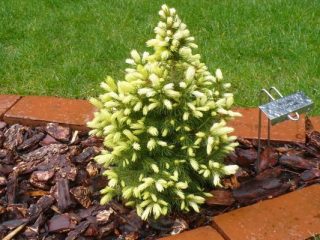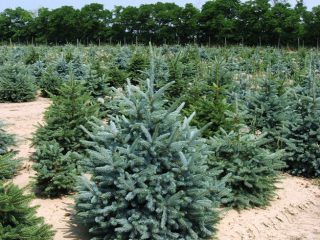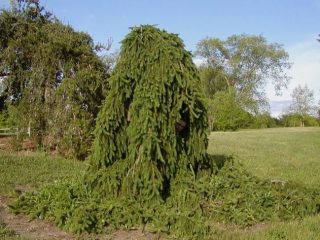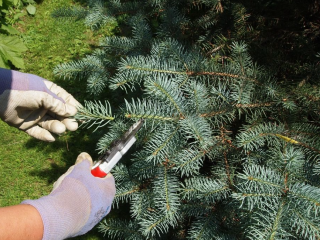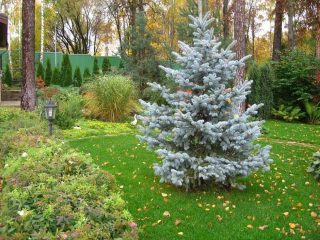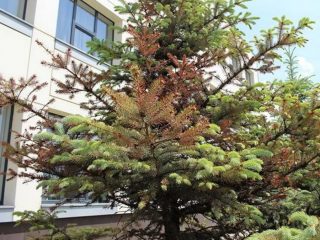Content
Super Blue prickly spruce is a beautiful coniferous tree with a thick blue crown and brown cones. Due to its high decorative value, rapid growth rate and resistance to winds, it is often planted in city parks and near public buildings.
Origin story
Prickly spruce Super Blue Seedling is the result of the work of Canadian breeders. It is grown from seeds and not by grafting, which makes it cheaper than other varieties with blue needles.
In its homeland, the tree is known as Picea pungens Super Blue Seedling.

The first two words of the name translated into Russian mean “prickly spruce”, the last three – “super blue seedling”
Description of the prickly spruce Super Blue
Super Blue Seedling is a tall, graceful spruce with a shallow root system and thin brown bark. Initially, its crown has a narrow conical shape, which transforms into a cylindrical shape with age.
Strong spruce branches are arranged horizontally, emphasizing the tiered structure of the above-ground part. They are covered with hard diamond-shaped needles, the length of which reaches 30 mm.

Depending on the growing conditions of the tree, its needles can be colored greenish, gray or bright blue.
Cylindrical tarred cones of Super Blue grow up to 5-10 cm in length and up to 2-3 cm in width. Initially they are colored reddish or yellowish-green, and as they ripen they turn brown. The cones contain black seeds with pale beige wings. Sometimes they stay on the branches until the next spring or autumn.
The lifespan of the Super Blue prickly spruce depends on the region of growth. Ephedra planted in North America will live 600-700 years. In central regions, the life expectancy of the Super Blue prickly spruce does not exceed 70 years.
Dimensions of prickly spruce Super Blue
The tree is a tall, fast growing variety. Every year it grows 30 cm in height and 15 cm in diameter. By the age of 30, the height of the Super Blue prickly spruce reaches 15 m with a width of 4-6 m.
Frost resistance
Super Blue Seedling spruce belongs to frost hardiness zone 4 (USDA). It tolerates temperatures well down to -34-40 0C.
Advantages and disadvantages
In terms of its decorative properties, the variety is superior to the famous Siberian spruce, but is inferior to it in winter hardiness. Due to its spectacular blue crown, it stands out from the background of other conifers.

The prickly spruce Super Blue Seedling is resistant to strong winds and air pollution, thanks to which it grows well in megacities
Pros:
- beautiful color of pine needles;
- fast growth rates;
- high frost resistance;
- immunity to fungal diseases.
Minuses:
- requirements for illumination.
Landing rules
Super Blue spruce grows well in open, sunny or slightly shaded areas.When grown in the shade, its needles change color and turn green instead of blue.
Almost any soil is suitable for planting a tree, but it is better if it is loam or sandstone. The soil for growing conifers should be light, loose and slightly acidic (pH 4.5-5.8).
The best time to plant Super Blue Seedling in open ground is considered to be from April to May. But this can be done in the fall, at least six weeks before the onset of frost. Planting is carried out on a cloudy, cool day, adhering to the following algorithm:
- In the selected area, dig a hole measuring at least 50x80 cm. When planting several conifers, the distance between adjacent holes should be 2-3 m.
- A drainage layer of broken brick or crushed stone is laid at the bottom.
- A hill is made on top of a mixture of peat, sand and turf soil, designed for the length of the roots of the seedling.
- A tree is placed in the center, the roots of which were previously soaked in a bucket of water and a growth stimulant, and sprinkled with the remaining soil so that the root collar is visible above the surface.
The seedling is watered with cool, settled water and, after absorbing moisture, mulched with sawdust or wood chips. Two sticks are driven in on both sides of the tree and a rope is tied to them so as to provide the conifer with reliable support. The structure must be durable and withstand strong gusts of wind.
Features of care
Although the Super Blue Seedling spruce is undemanding in care, it requires the following basic agrotechnical manipulations:
- Watering.The ground under mature conifers is moistened once every 14 days, pouring at least 12 liters of water under each tree. Young spruce trees are watered weekly and, if possible, their crowns are sprinkled with a hose or watering can.
- Soil treatment. The soil under the Sidling variety is regularly loosened to a depth of 7 cm to slow down the evaporation of moisture and the growth of weeds, and the soil is covered with a layer of mulch.
- Feeding. The bulk of fertilizers are applied during the process of planting conifers. Then every year in early spring, before young shoots appear, the tree is fed with universal mineral compounds, with preference given to liquid forms.
- Shelter for the winter. Mature spruce is characterized by high frost resistance and does not require additional insulation. It is better to cover young conifers that have not reached the age of five for the winter with non-woven material, and mulch the roots.

The lush, dense crown of the prickly spruce begins to form immediately after planting the tree; the conifer needs only sanitary trimmings
Reproduction
Super Blue Seedling spruce can be propagated in several ways:
- Seeds. A risky method that does not guarantee 100% results. Half of the seeds usually do not germinate, and eight out of ten seedlings that hatch do not have the declared varietal characteristics. 12 hours before sowing, the seeds, previously extracted from the dried cones, are soaked in a solution of an antifungal agent. Then the planting material is placed in small containers with soil and covered with a 20 mm layer of peat and sawdust mulch. The first shoots will appear in about 1.5 weeks. Among them, those that are blue in color are selected and sprayed with a spray bottle once every two days. Three years later, the seedlings are transplanted into open ground, having previously hardened them.
- Cuttings.Planting material is harvested in April or May. Cuttings with a maximum length of 12 cm are cut with a piece of bark from a tree older than five years and planted in containers with perlite or sand-peat mixture at an angle of 300 to a depth of about 2 cm. During the year, seedlings are grown in greenhouse conditions and then hardened off, systematically taken outside. Planting in open ground is carried out no earlier than three years later.
Diseases and pests
Under unfavorable conditions, Super Blue spruce becomes susceptible to diseases such as:
- Schutte. A fungal disease that appears immediately after the snow melts is accompanied by the appearance of brown spots.
Infection can be prevented by treating with Bordeaux mixture in the spring or summer.
- Rust. The branches of the affected conifer are covered with swollen red spots.
To save the tree, infected shoots must be cut off, and the plant itself is treated with Bordeaux mixture (10 g/l of water)
Of the pests, the greatest danger to the Super Blue prickly spruce is the spruce sawfly, spider mite and hermes spruce. You can get rid of insects using insecticides.
Prickly spruce Super Blue in landscape design
Ephedra is used in both single and group plantings. Super Blue is often used for landscaping city parks and squares. In private homes it is planted near verandas or gazebos.

Prickly spruce looks good next to flowers and other plants of a contrasting shade

Successful neighbors for Super Blue will be mountain pines, Korean fir, Ginnala maple and white weeping willow.
Conclusion
Spruce Super Blue is a spectacular tree with lush blue needles and brown cones. The variety is valued for its high decorativeness and frost resistance and is successfully used for beautifying public places and private households.
Reviews of blue spruce Super Blue






